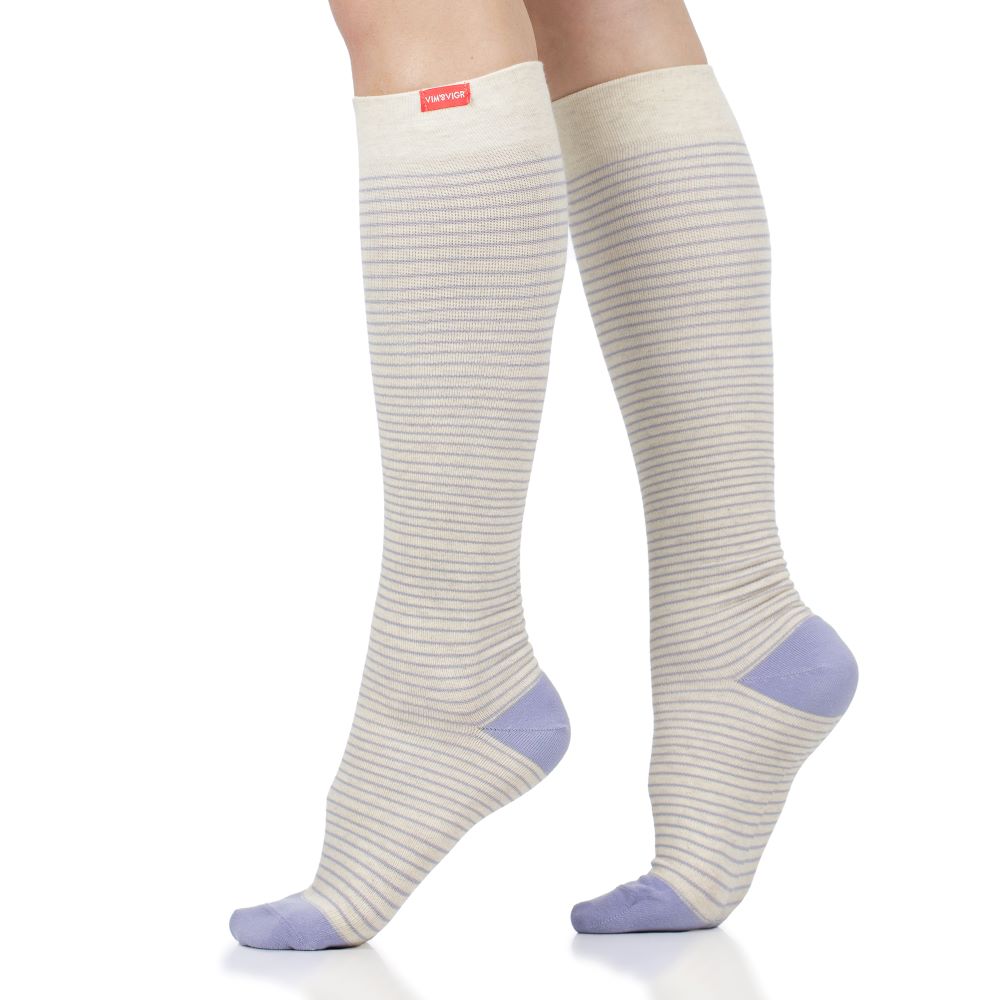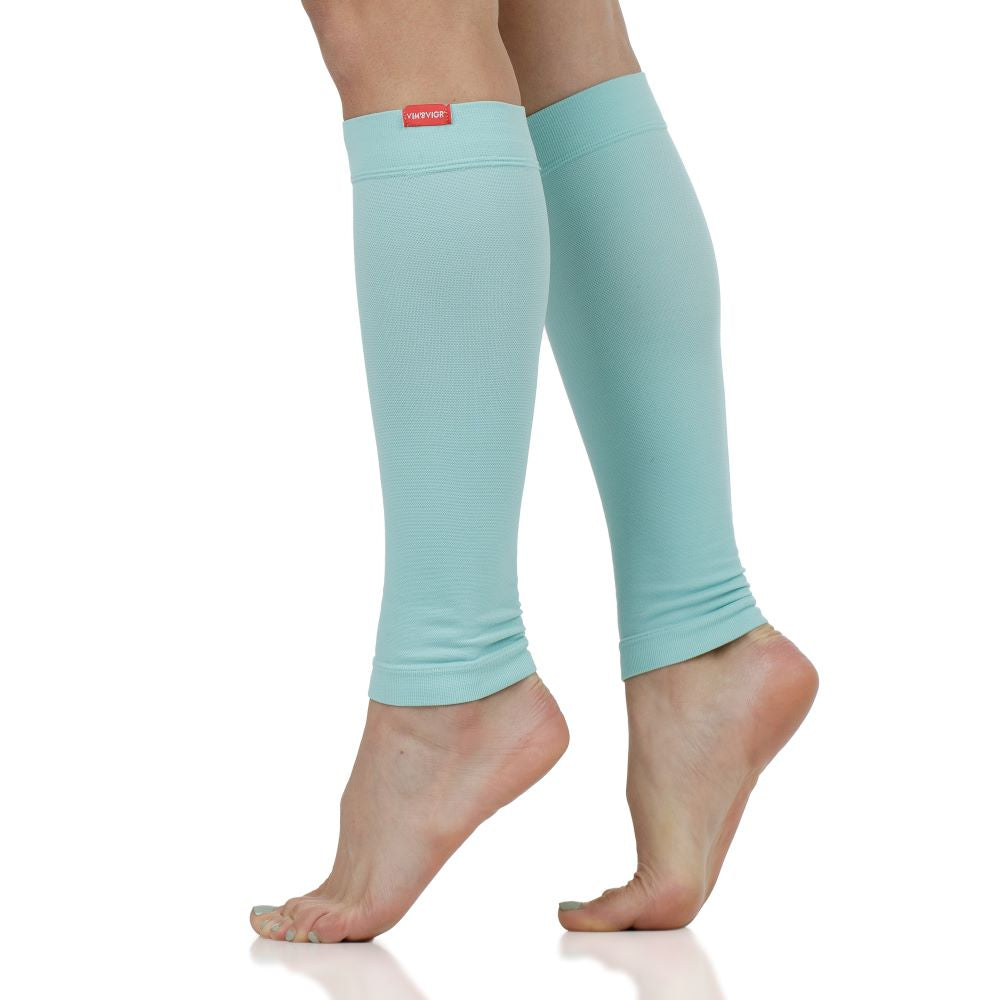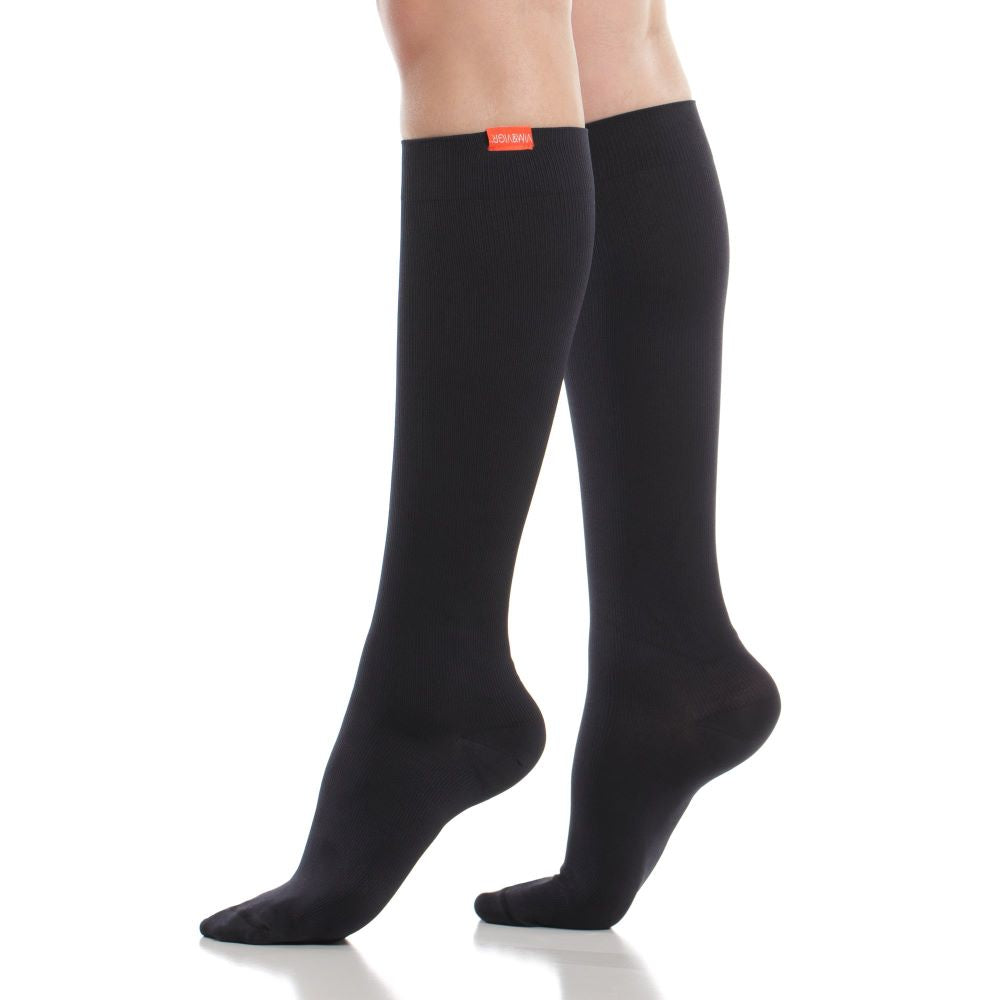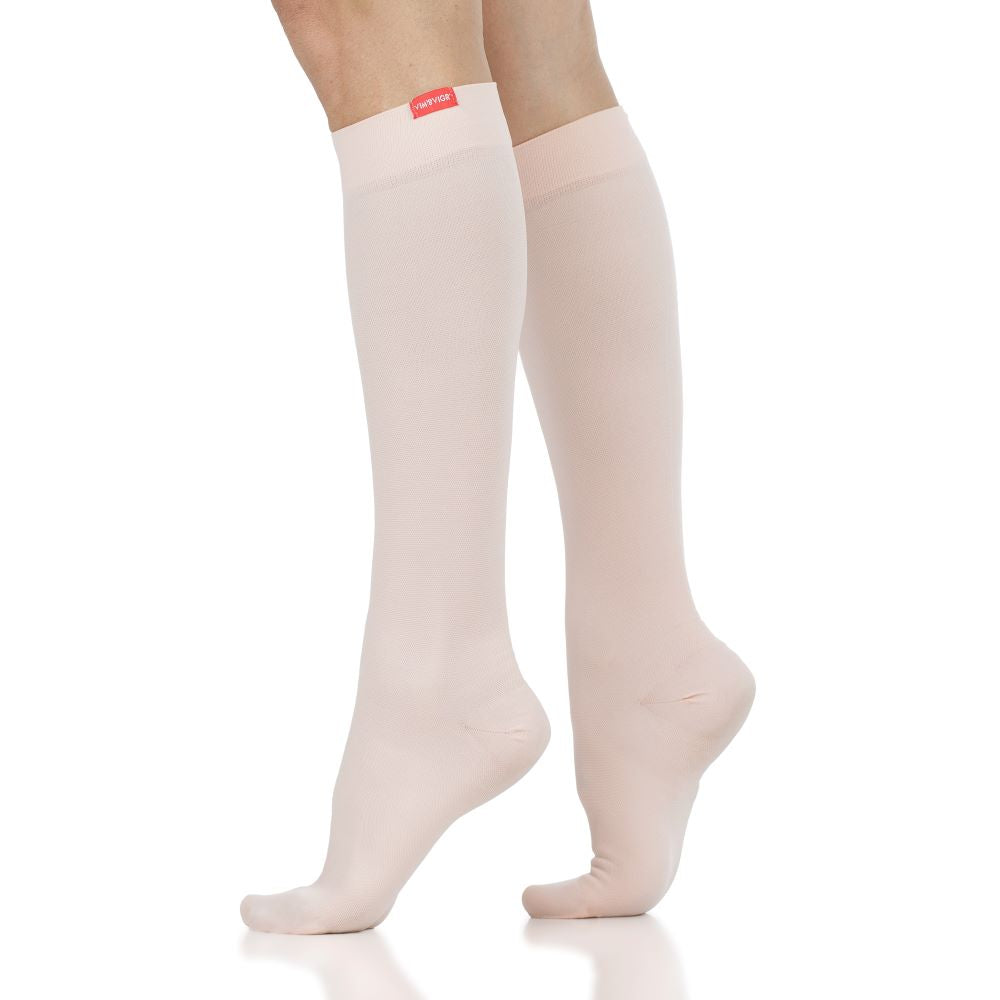What are the Side Effects of Wearing Compression Stockings?
Compression socks and stockings are great. We know they help improve circulation, stimulate blood flow so you avoid swelling or blood clots, and support recovery after long days out on your feet. Whether you’re a hiker or a runner, or simply someone who walks a lot for their day job, you’ll have enjoyed relief from swollen ankles and legs from your compression socks. And, if you’re pregnant or suffering from conditions such as Deep Vein Thrombosis (DVT) or chronic venous insufficiency, chances are your doctor has recommended using compression therapy as part of your treatment.

However, as with anything, you might be wondering: Can compression socks be bad for you? Are there negative side effects of wearing compression stockings all day or over night? And when should you not wear compression garments?
To find out whether wearing compression socks can be harmful, we’ll review the cases where you may want to avoid them. We’ll also look at potential side effects, as well as at positive outcomes from wearing them. Read on to find out everything you’ve ever wanted to know about compression socks side effects and how to avoid them, too!
Potential Side Effects of Wearing Compression Stockings
Depending on personal circumstances (such as if you’re allergic to some materials you might find in compression socks), you could experience some negative effects from wearing them. However, most people will not suffer from any of these if they wear good-quality, well-fitting compression garments.
Skin Itching, Redness, or Irritation
Low quality materials or fabrics that you could be allergic to can create irritation of the skin. These compression socks can also cause itching and redness. If you pick your socks carefully, checking that the materials don’t cause rashes or breaking out, then you should not need to worry about this sort of side effect.
Restricted Circulation
There is a common misconception that compression socks restrict your circulation. On the contrary: if your socks are the right size and compression level for you, the opposite will happen. Graduated compression supports good blood flow and will support blood being transported back into your cardiovascular system.
Bruising or Chafing
Ill fitting or low quality compression socks also may lead to bruising or chafing. Sometimes, compression socks made with poor quality material can create a rash or become really uncomfortable with prolonged wear.
Leg Achiness After Wearing
After wearing compression socks, your legs should feel light and energized. If your socks are too tight, however, you’ll be desperate to take them off and feel sore afterwards.
Ways to Avoid Negative Compression Socks Side Effects
The key way to ensure you’re wearing the right compression socks is to go for high-quality, comfortable and adequate materials that work with your body and your activity levels. Here are our best tips to achieve this.
Choose the Right Size Compression Socks
It is critical that your compression socks are the correct size for them to fit well and provide benefits. Wear them too loose and you will not see any benefit. Wear them too tight and you’ll be sore, uncomfortable and itchy or bruised. Follow our detailed guide on how to find the right size here.
Choose the Right Compression Level
Not all compression socks are the same. Most manufacturers offer different levels of compression, starting with the more casual, everyday-appropriate moderate 15-20 mmHg and going up to 30-40 mmHg (firm, prescription level socks). Find out more about these compression levels here.
If it’s your first time wearing compression socks and you’re simply looking to alleviate symptoms of tired, swollen legs, then we recommend that you get a first pair at 15-20 mmHg, get used to how they feel, and then decide whether you need more pressure later on.
Opt for Graduated Compression
Graduated compression simply means that the socks are not exerting the same level of pressure throughout. Our range of compression socks apply more pressure at the ankle, slowly reducing this level as they go up towards the knee.
The benefit of this approach is that blood flow is directed upwards, contributing to better circulation and to reducing swelling.
Wear Your Compression Socks Correctly
It may seem simple, but putting on compression socks correctly is very important. Wearing them too low down will prevent your calf muscles from benefiting from the compression and can even cause bruising and discomfort. You also should avoid bunching and folding. Here’s a detailed guide on how to put on compression socks correctly to help you out.
Can Wearing Compression Socks Be Harmful?
Compression socks work well for anyone who puts a lot of stress on their feet daily, or for those whose lower limbs need a bit of TLC. However, it’s important to acknowledge that using compression socks (unless medically prescribed) is a matter of personal preference. While many of us will love the feeling of graduated pressure that starts at the ankle and eases off towards the knee, some people might find that constricting and uncomfortable.
There are also many “myths” around what wearing compression socks can do:
- “Cut off” your circulation. Compression socks are designed to improve circulation, however, many fear the opposite will happen. This is because of a misunderstanding around how compression socks work. Low-quality, poorly fitted socks could become a blood flow blocker. However, wearing good-quality socks that fit you well should stimulate good circulation instead.
- Compression socks will bruise and chafe your skin. Again, this is probably borne out of the concern that the tightness of the socks can harm your muscles and your skin. In fact, compression socks are generally made from gentle fabrics like Merino wool and cotton, that are not in any way harmful to your skin. Moreover, Merino wool is hypoallergenic and therefore less likely to irritate. If your compression socks are too tight, however, they could lead to bruising.
- Compression socks are for old, bed-ridden people. While compression stockings and socks can help with recovery from surgery and are prescribed in conditions like Deep Vein Thrombosis, they’re certainly not just for those who are less mobile. In fact, wearing compression socks during hiking or running can be a great way to support your muscles while improving circulation. Additionally, it’s definitely not an age-related matter whether you’d like to boost your blood flow and have your legs feel lighter and fresher when you go on long trips or sit or stand for long periods of time!
Who Should Avoid Wearing Compression Socks?
For all their benefits, compression socks may be problematic for some. There are very specific categories of people who should steer clear of compression:
- Those suffering from ischemia (advanced arterial disease);
- If you have untreated septic phlebitis;
- If you have been diagnosed with uncontrolled congestive heart failure;
- Those suffering from phlegmasia cerulea dolens.
People who suffer from arthritis, concomitant dermatoses or advanced peripheral neuropathy will also be discouraged from using compression stockings.
Finally, if you have an intolerance to particular compression stocking materials, like Nylon for example, you need to be aware of this and avoid those types of garments. This doesn’t mean you cannot enjoy cotton compression socks, however.

Positive Effects of Wearing Compression Socks
So, what are the positives of wearing good-quality, graduated compression socks in a material that suits your activity levels and the environment? Here are just some of the benefits.
Improved Blood Circulation
Thanks to the way that graduated compression socks apply more pressure to the ankle, gradually decreasing it as they go up towards the knee, compression socks support blood flow back towards the heart. This means that you’re less likely to develop blood clots, have blood pooling towards your ankles causing “heavy feet,” and generally you’ll be feeling better and lighter.
Improved blood circulation also benefits the transfer of oxygen to your muscles, helping with post-exercise recovery.
Reduced Leg and Feet Swelling and Fatigue
A lot of people who use compression socks or stockings in everyday life do so to prevent fluid build-up in the lower limbs. This occurs when you stand a lot or when you sit for hours at a time without breaks for movement (for example, when you travel on a plane).
Pregnant women also benefit from reduced swelling in their feet and legs thanks to compression socks.
Improved Energy Levels
Overall, as blood flows better in your lower limbs and you avoid fluid build-up and blood clots, your legs will feel lighter and fresher. This is why wearing compression socks also leads to better energy levels overall.
The benefit of improved blood circulation may start with your feet and legs, but it expands throughout your body. This is what can give a boost of energy and general wellbeing, from the small gesture of wearing compression socks.
Reduce the Symptoms of Some Chronic Diseases
Finally, compression socks are prescribed by medical professionals for people suffering from certain chronic diseases. They are known to help avoid the formation of blood clots and can even help dislodge one if it’s already been formed. Moreover, compression socks can help prevent the development of varicose veins and Deep Vein Thrombosis. If such conditions already exist, they’ll help relieve their symptoms, too.
Making the Most Out of Your Compression Stockings and Socks
As long as your compression socks fit well, exert enough pressure to stimulate your blood flow, and are made of good-quality, durable and comfortable materials, you shouldn’t need to deal with any unwanted side effects. Browse through our range of materials, pressure levels and styles here to find your perfect pair.
Shop all of our stylish compression socks here!



















Leave a comment